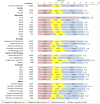Increase in the Length of Lung Cancer Patient Pathway Before First-Line Therapy: A 6-Year Nationwide Analysis From Hungary
- PMID: 35002544
- PMCID: PMC8734146
- DOI: 10.3389/pore.2021.1610041
Increase in the Length of Lung Cancer Patient Pathway Before First-Line Therapy: A 6-Year Nationwide Analysis From Hungary
Abstract
Objective: This study aimed to examine the characteristics of the lung cancer (LC) patient pathway in Hungary during a 6-years period. Methods: This nationwide, retrospective study included patients newly diagnosed with LC (ICD-10 C34) between January 1, 2011, and December 31, 2016, using data from the National Health Insurance Fund (NHIF) of Hungary. The following patient pathway intervals were examined: system, diagnostic and treatment interval by age, gender, tumor type, study year and first-line LC therapy. Results: During the 6-years study period, 17,386 patients had at least one type of imaging (X-ray or CT/MRI) prior to diagnosis, and 12,063 had records of both X-ray and CT/MRI. The median system interval was 64.5 days, and it was 5 days longer among women, than in men (68.0 vs. 63.0 days). The median system interval was significantly longer in patients with adenocarcinoma compared to those with squamous cell carcinoma or small cell lung cancer (70.4 vs. 64.0 vs. 48.0 days, respectively). Patients who received surgery as first-line treatment had significantly longer median system intervals compared to those receiving chemotherapy (81.4 vs. 62.0 days). The median system interval significantly increased from 62.0 to 66.0 days during the 6-years study period. Conclusion: The LC patient pathway significantly increased in Hungary over the 6-years study period. There were no significant differences in the length of the whole LC patient pathway according to age, however, female sex, surgery as first-line treatment, and adenocarcinoma were associated with longer system intervals.
Keywords: episode of care; lung cancer; patient pathway; system interval; time to treatment.
Copyright © 2021 Kiss, Bogos, Tamási, Ostoros, Müller, Urbán, Bittner, Sárosi, Vastag, Polányi, Nagy-Erdei, Knollmajer, Várnai, Nagy, Horváth, Rokszin, Abonyi-Tóth, Barcza, Moldvay, Gálffy and Vokó.
Conflict of interest statement
ZK, AV, ZP, ZN-E, KK, and MV are employees of MSD Pharma Hungary Ltd. MV is a research fellow at Semmelweis University. KH is a research fellow at Eötvös Loránd University. BN and ZV are employees at Eötvös Loránd University where their contribution to this project was financially compensated. KB and GO are employees of National Korányi Institute of Pulmonology and have received speaker honorarium from MSD Hungary. GG is employee of Oncology Center of Törökbálint and has received speaker honorarium from MSD Hungary. GR and ZA-T are employees of RxTarget Ltd. where their contribution to this project was financially compensated. ZB is employee of Syntesia Ltd. and her contribution to this project was financially compensated. The programme is financed by MSD Pharma Hungary Ltd. JM was supported by the Hungarian Brain research Program (grant 2017-1.2.1-NKP-2017-00002), and the Hungarian NRDI Office (grant K-129065). The remaining authors declare that the research was conducted in the absence of any commercial or financial relationships that could be construed as a potential conflict of interest. The authors declare that this study received funding from MSD Pharma Hungary Ltd. The funder had the following involvement with the study: development of study design, data collection, data analysis, interpretation of data, the writing of this article and the decision to submit it for publication.
Figures




Similar articles
-
Significant changes in advanced lung cancer survival during the past decade in Hungary: impact of modern immunotherapy and the COVID-19 pandemic.Front Oncol. 2023 Oct 4;13:1207295. doi: 10.3389/fonc.2023.1207295. eCollection 2023. Front Oncol. 2023. PMID: 37860193 Free PMC article.
-
Improvement in Lung Cancer Survival: 6-Year Trends of Overall Survival at Hungarian Patients Diagnosed in 2011-2016.Pathol Oncol Res. 2021 Apr 30;27:603937. doi: 10.3389/pore.2021.603937. eCollection 2021. Pathol Oncol Res. 2021. PMID: 34257563 Free PMC article.
-
Age and Gender Specific Lung Cancer Incidence and Mortality in Hungary: Trends from 2011 Through 2016.Pathol Oncol Res. 2021 Apr 30;27:598862. doi: 10.3389/pore.2021.598862. eCollection 2021. Pathol Oncol Res. 2021. PMID: 34257553 Free PMC article.
-
Underlying reasons for post-mortem diagnosed lung cancer cases - A robust retrospective comparative study from Hungary (HULC study).Front Oncol. 2022 Nov 25;12:1032366. doi: 10.3389/fonc.2022.1032366. eCollection 2022. Front Oncol. 2022. PMID: 36505881 Free PMC article.
-
Impact of a Targeted Project for Shortening of Imaging Diagnostic Waiting Time in Patients with Suspected Oncological Diseases in Hungary.Medicina (Kaunas). 2023 Jan 12;59(1):153. doi: 10.3390/medicina59010153. Medicina (Kaunas). 2023. PMID: 36676777 Free PMC article.
Cited by
-
Overall Survival of Hungarian Cancer Patients Diagnosed Between 2011 and 2019, Based on the Health Insurance Fund Database.Cancers (Basel). 2025 May 15;17(10):1670. doi: 10.3390/cancers17101670. Cancers (Basel). 2025. PMID: 40427166 Free PMC article.
-
Improvements in cancer survival in Hungary: a nationwide epidemiology study between 2011-2019 based on a health insurance fund database.Front Oncol. 2025 Apr 3;15:1446611. doi: 10.3389/fonc.2025.1446611. eCollection 2025. Front Oncol. 2025. PMID: 40248209 Free PMC article.
-
Early-stage resectable non-small cell lung cancer in Hungary.Pathol Oncol Res. 2025 Jul 28;31:1612152. doi: 10.3389/pore.2025.1612152. eCollection 2025. Pathol Oncol Res. 2025. PMID: 40791752 Free PMC article.
References
-
- International Agency for Research on Cancer, (2019) Globocan: Lung Cancer Fact Sheet 2018. Available at: http://gco.iarc.fr/today/data/factsheets/cancers/15-Lung-fact-sheet.pdf ... .
MeSH terms
LinkOut - more resources
Full Text Sources
Medical

